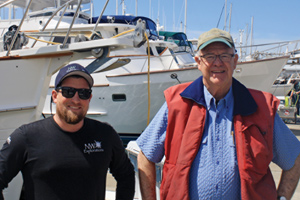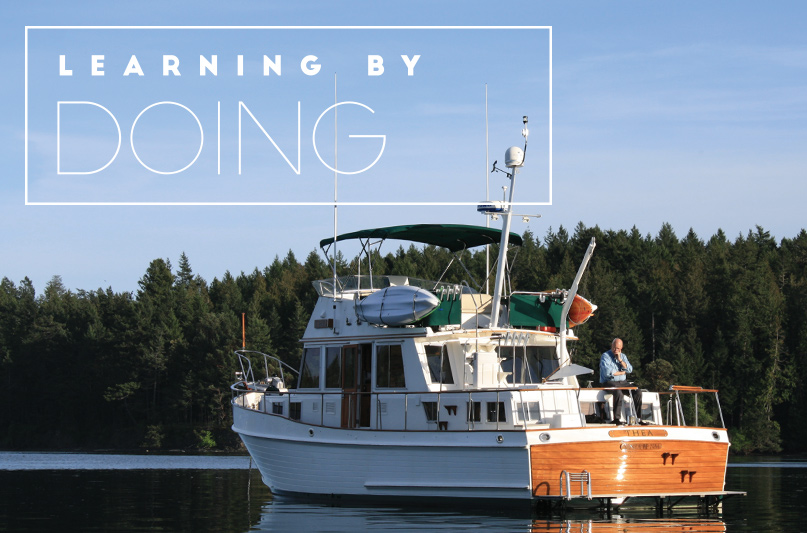
nautical education in a multiday experience with Northwest Explorations.
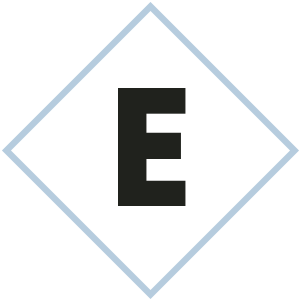 Early this past May, I found myself in tiny Prevost Harbor on Stuart Island at the helm of Thea, a 46-foot Grand Banks. With my hand on the throttle, Thea was headed straight for a horizontal rope suspended between two large buoys that serves as moorage for overnight visitors to the harbor.
Early this past May, I found myself in tiny Prevost Harbor on Stuart Island at the helm of Thea, a 46-foot Grand Banks. With my hand on the throttle, Thea was headed straight for a horizontal rope suspended between two large buoys that serves as moorage for overnight visitors to the harbor.
I was on a three-day trip, part of a course covering all the fundamentals of piloting a motor yacht. To my left was Brian Pemberton, founder of Northwest Explorations (NWE) and the captain and lead instructor for the weekend.
I was using the rope dock to practice my docking technique, the flexible target more forgiving of amateurs than a traditional dock. “Starboard engine forward,” Pemberton said, as he explained the strategy of docking a boat. “Aim for a little ahead of the center of the dock and approach it at about a 45° angle.”
Thea’s engines idled as we made our way to the dock. I tried to recall Pemberton’s instructions as the moment of truth approached. I put the port engine into reverse at the last second to swing the boat over and then put the engines into neutral.
We silently close the gap and I only wince slightly as the hull presses just a little too much into the rope. “That was excellent for your first time docking,” Pemberton tells me encouragingly. That support made me feel a little better, but I knew I had a long way to go. “Let’s swing back out for another attempt,” said Pemberton.
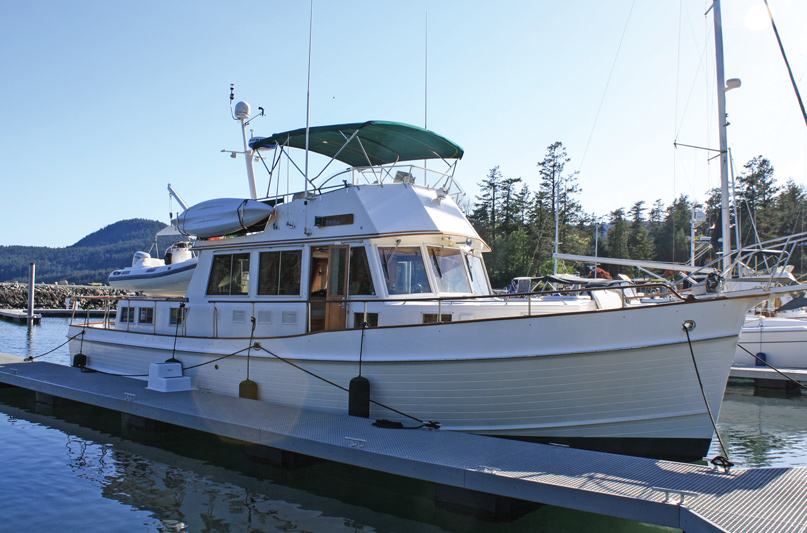
We finished up our docking practice and moved on to the next exercise. While most people who take the 3-Day Powerboat training course are there to brush up on their skills, I was there because I didn’t have any skills to begin with. My boating experience is more limited than I’d like.
Besides time in canoes and personal water craft, my time on boats has been spent as a guest of friends and family, where I could put my feet up and enjoy the good life while someone else had to worry about engine oil levels and finding moorage for the night. I jumped on this course when I thought maybe it was time to learn the finer points of piloting a boat.
Based on the number of boating education classes available in the area, it seems many other people feel the way I do about their boating knowledge. Aimed at new boaters, but generally taking students of all skill levels, these classes can range in scope from docking and casting off to the detailed minutia of marine electronic systems.
They’re offered for powerboats and sail boats by many organizations and there are also numerous independent captains who can be hired to provide private lessons. I joined the 3-Day Powerboat course at Northwest Explorations, a multi-day class with a broad focus on every aspect of powerboating to learn more.
Two days earlier at NWE’s Bellingham office, I was greeted by their charter manager Emmelina Mojica, and Ryan Downs, who would be serving as the first mate and an instructor during the course.
We walked down the new docks, past a small fleet of shining white Grand Banks, to meet a couple named George and Annette, a pair of newly retired professors who were looking to dip their toes in boating and who would be the other students in the course. We all introduced ourselves and were told that Pemberton would meet with us tomorrow morning before casting off.

We spent the night on the boat and were greeted with a clear day once the morning haze burned off. Pemberton arrived early and we gathered in the cabin so he could go over the focus of the weekend. We would be covering the broadest range of topics as possible, from engine maintenance to docking to navigation to VHF radios.
True to his word, minutes later the floors of the galley were pulled up to reveal the engine room and three of us at a time squeezed in to learn about engines, coolant levels, and sea water filters. “Diesel is dyed pink, which makes it easier to identify leaks from the engines,” Downs said. “Checking the pads under the engine in the morning is a good way to keep an eye on any new leaks.”
He explained how to check the dipsticks, noting the area between two notches in the stick indicate the correct amount of oil in the engine. “Shine a light into the sea filter to check for anything that’s been sucked into the filter. Usually it will be seaweed, but every once in a while, there might be a jellyfish.” We practiced detaching shore power cables and taking in fenders before casting off for real, heading out of Squalicum Harbor for the San Juan Islands.
On the open water, George, Annette, and I took turns at the helm as Downs and Pemberton explained the responsibilities of the captain and the lookout. “The crew member at the helm needs to have eyes on the horizon and on the instruments in front of them, but also be looking over their shoulder before moving port or starboard,” Pemberton explains. “The lookout serves as an additional set of eyes that are constantly scanning around the boat. Be sure to call out any boats or objects that appear, especially if they’re in the skipper’s blind spot.”
A Saturday morning sailing race was underway, and Downs had us looking for bright orange race markers. “This boat here is most likely a judge, see how its bow swung to starboard? They are giving us a good indication of what they plan to do and we have plenty of time to maneuver around them.” Downs gave us the rules of the road (or water) lesson.
“Generally, you should clearly indicate which direction you intend to go by turning and holding that heading. If there is any confusion about what an oncoming vessel intends to do, hailing them over the radio is an option.”
As we passed Lummi Island, we took out the paper charts and got a lesson in plotting a course and reading the topography of a map. “See how one side of Lummi Island is flat, and the other is elevated? That’s reflected in the topography lines on the charts,” Downs says. “Now, you can see something similar in the water. The depth is marked in a similar way. Anything the boat might collide with, like rocks, reefs, or shoals, are also marked.”
The day’s journey was my first experience of being at the helm for an extended period. Before today, I had never needed to pay attention to blobs on radar screens, charts, or how many knots we were making. My attention this day was pulled between watching the horizon, chart plotter, and the indistinct voices coming in over the VHF radio.
Pemberton asked for opinions on where we would anchor for the night, listing a handful of possible locations. We settled on Prevost Harbor on Sinclair Island, and Pemberton asked me to change course slightly. After the decision was made, the sense of freedom and spontaneity that must come over everyone the first time they’re at the helm visited me, and I began to imagine how easy it would be to swing the bow north and head to Haida Gwaii or Alaska.
It was the same thrill that teenagers feel when they get behind the wheel of their first car. Before, being on the water had all been about having fun on deck and taking in the sights, but with the added responsibility came another level of enjoyment.
We arrived in Prevost Harbor and decided it was the right time for a lesson in laying anchor. Pemberton displayed some hand signs meant to relay instructions to the cabin on how much chain to release. The bottom of the harbor was a dark mud that was perfect for anchoring, and Pemberton explained the technique of getting an anchor to dig in and the scope necessary for a secure set.
“For a lighter anchor like the one we have, a scope of 1:5 is necessary, meaning if we were in 10 feet of water, we would need to lay 50 feet of chain.
The scope can go all the way up to 1:10 if we really wanted to be confident that we weren’t going anywhere.” We practiced launching the dinghy and took it for a cruise while Pemberton got dinner ready.
The next morning docking practice began, with George, Annette, and me each taking turns at the wheel. Improvements came quickly with the guidance of Downs and Pemberton, and by mid-day, we were exponentially better than we had been that morning. Crew overboard drills followed the docking practice; a life ring was tossed in the water and the docking hooks came out. The three of us formed a communication chain with one on the flydeck, one with the hook, and the third calling instructions in between. I’m proud to say I only backed into our poor drifting crewman once.
Thea pulled out of Prevost Harbor and headed toward Orcas Island. I was feeling pretty good about the successful docking practice and the clear weather we were lucky to have in early May. The night before during a course-plotting lesson, Annette worked with Pemberton to chart a course free of rocks and shoals.
Up until this point, as a novice boater, navigating through currents and tides, and reading bathymetric charts had always been the most mystifying of boating skills. Visions of geometry and sextants and finding the North Star always filled my head when captains started talking about plotting a course, though I knew GPS and radar had made these skills often-neglected back-ups. After even a few hours of reading charts, most of my trepidation had vanished and I felt I could avoid just about any obstacle—around the tranquil San Juans, that is.
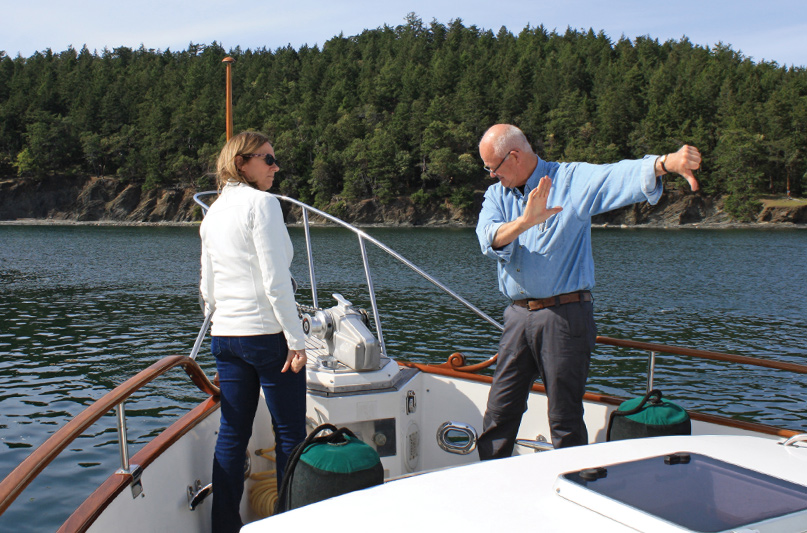
We arrived at the Rosario Resort in the early afternoon, the resort’s original structure of Moran Mansion majestically overlooking the docks. This was our first true docking practice, as we’d only practiced casting off and anchoring until now.
With Annette and Pemberton at the helm, the Thea glided into our assigned slip and I stepped off quickly, Pemberton’s lesson fresh in my mind: “If you have to jump, the boat isn’t close enough. You can always put it into reverse and try again.” My cleat knot was less than spectacular, and docking was followed with some knot tying practice. “One of the trickiest parts is learning the knots,” Pemberton offers. “It was the same when I taught mountaineering.”
The final leg back to Squalicum Harbor passed quickly as we dodged kayakers and other cruisers taking advantage of the good weather. I was at the wheel as we approached the harbor, appreciating the radar screens and powerful binoculars on the helm. They seemed to fulfill some childhood dream and using them made me feel like I was charting unknown waters.
I’d had binoculars as a kid, but this was the first time they’d ever served a practical purpose. All three of the weekend’s students had come a long way. It was amazing how much knowledge I’d picked up over just a few days.
On idle, the Grand Banks headed for the Northwest Explorations docks. I stood with my hands on the transmission, putting the one engine in forward, then the other, then both in reverse, and so on as Pemberton advised me on the Thea’s final docking of the weekend.
With much help from Pemberton, the boat effortlessly found her spot on the dock. It was a testament to the education we’d received, that just days earlier I couldn’t even read a chart, and now, I was already making detailed plans of my next excursion. I couldn’t wait to get out on the water again to put my skills to the test.
